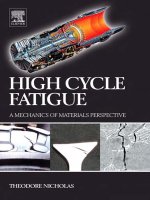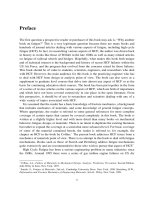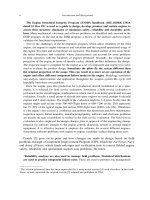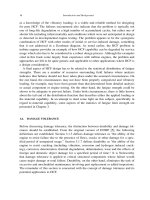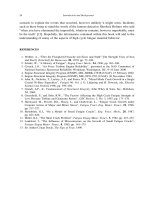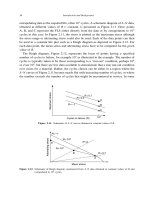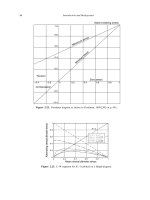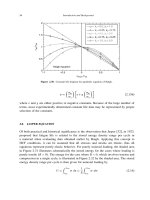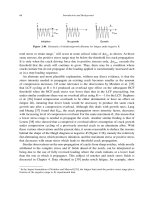High Cycle Fatigue: A Mechanics of Materials Perspective part 49 pps
Bạn đang xem bản rút gọn của tài liệu. Xem và tải ngay bản đầy đủ của tài liệu tại đây (156.14 KB, 10 trang )
466 Applications
It is clear, then, that if the pressure is sufficient to cause yielding of the cylinder due to hoop
stresses beyond the elastic limit, this yielding will take place first at the inner diameter.
The residual stress state that results from plastic straining will depend on the cylinder
geometry, material strain-hardening characteristics, unloading behavior of the material,
and the level of strain hardening imposed. A typical circumferential stress state near the
inner diameter (see [70] for example) is depicted schematically in Figure 8.78 where
the tensile stresses due to loading are added to the residual stresses, the latter being
compressive. The net stresses can then be used to calculate the resultant value of K, the
stress intensity, using methods such as weight functions as done in [70]. In that article,
the authors point out that the computed stress intensity is the sum of the contributions due
to the internal pressure loading, the residual stresses, and the internal pressure acting on
the crack faces. The resulting values of K can be as depicted schematically in Figure 8.79
where the value of K decreases with increase in crack length near the inner diameter.
Thus, it is possible for a crack to initiate but arrest due to the decrease in K with crack
length as depicted. As long as the stress intensity is below threshold, there should be no
further crack extension.
In determining the threshold for crack propagation, two issues should be considered.
First, it should be established whether the applied cyclic loading is in the LCF or HCF
regimes. If it is in HCF, involving very large cycle counts, then the use of K
th
is
warranted. On the other hand, if the loading is LCF involving a low number of cycles
such as start up and shut down of a mechanical system, then the use of K
th
can be
conservative because K
th
typically corresponds to a growth rate of 10
−10
m/cycles (see
Section 8.4). A value of K corresponding to a higher growth rate would suffice, provided
that the total crack extension during LCF was within acceptable limits. The second issue,
Applied
stress
Superposition
Residual
stress
ID
OD
Stress
Figure 8.78. Schematic diagram of stresses near inner diameter of pressurized cylinder.
HCF Design Considerations 467
ID
OD
Stress intensity
Crack
location
Figure 8.79. Schematic diagram of stress intensity in pre-stressed pressurized cylinder.
one that is normally neglected in design, is to use a value of K
th
that represents the
threshold of the material that has been subjected to strain hardening. Since such data are
rarely available, this procedure is normally not followed and the values of K
th
for the
unstrained material are sufficient, if not conservative. From a technical point of view,
the local strain hardening near the crack tip during crack growth far exceeds the strain
hardening applied to the bulk material during the autofrettage process. Thus, the use of
K
th
of the unstrained material is acceptable.
REFERENCES
1. Nicholas, T. and Maxwell, D.C., “Mean Stress Effects on the High Cycle Fatigue Limit Stress
in Ti-6Al-4V”, Fatigue and Fracture Mechanics: 33rd Volume, ASTM STP 1417, W.G. Reuter
and R.S. Piascik, eds, American Society for Testing and Materials, West Conshohocken, PA,
2002, pp. 476–492.
2. Tabernig, B., Powell, P., and Pippan, R., “Resistance Curves for the Threshold of Fatigue Crack
Propagation in Particle Reinforced Aluminium Alloys”, Fatigue Crack Growth Thresholds,
Endurance Limits, and Design, ASTM STP 1372, J.C. Newman, Jr., and R.S. Piascik, eds,
American Society for Testing and Materials, West Conshohocken, PA, 2000, pp. 96–108.
3. Smith, S.W. and Piascik, R.S., “An Indirect Technique for Determining Closure-Free Fatigue
Crack Growth Behavior”, Fatigue Crack Growth Thresholds, Endurance Limits, and Design,
ASTM STP 1372, J.C. Newman, Jr., and R.S. Piascik, eds, American Society for Testing and
Materials, West Conshohocken, PA, 2000, pp. 109–122.
468 Applications
4. Haake, F.K., Salivar, G.C., Hindle, E.H., Fischer, J.W., and Annis, C.G., Jr., “Threshold
Fatigue Crack Growth Behavior”, WRDC-TR-89-4085, Wright-Patterson AFB, OH, October
1989 (ADA218063).
5. Larsen, J.M., Worth, B.D., Annis, C.G., Jr., and Haake, F.K., “An Assessment of the Role of
Near-Threshold Crack Growth in High-Cycle-Fatigue Life Prediction of Aerospace Titanium
Alloys under Turbine Engine Spectra”, Int. J. Fracture, 80, 1996, pp. 237–255.
6. Cowles, B.A., “High Cycle fatigue in Aircraft Gas Turbines – An Industry Perspective”, Int.
J. Fracture, 80, 1996, pp. 147–163.
7. Nicholas, T. and Zuiker, J.R., “On the Use of the Goodman Diagram for High Cycle Fatigue
Design”, Int. J. Fracture, 80, 1996, pp. 219–235.
8. Guedou, J Y. and Rongvaux, J M., “Effect of Superimposed Stresses at High Frequency on
Low Cycle Fatigue”, Low Cycle Fatigue, ASTM, Philadelphia, 1988, pp. 938–969.
9. Hawkyard, M., Powell, B.E., Husey, I., and Grabowski, L., “Fatigue Crack Growth under
Conjoint Action of Major and Minor Stress”, Fatigue Fract. Eng. Mater. Struct., 19, 1996,
pp. 217–227.
10. Engine Structural Integrity Program (ENSIP), MIL-STD-1783 (USAF), 30 November 1984.
11. Morrissey, R.J., McDowell, D.L., and Nicholas, T., “Frequency and Stress Ratio Effects in
High Cycle Fatigue of Ti-6Al-4V”, Int. J. Fatigue, 21, 1999, pp. 679–685.
12. Paris, P.C. and Tada, H., “Near Threshold Fatigue Crack Growth versus Long Finite Life”,
Fatigue Fract. Eng. Mater. Struct., 25, 2002, pp. 727–733.
13. Skorupa, M., “Load Interaction Effects during Fatigue Crack Growth under Variable Amplitude
Loading – A Literature Review. Part I: Empirical Trends”, Fatigue Fract. Eng. Mater. Struct.,
21, 1998, pp. 987–1006.
14. Skorupa, M., “Load Interaction Effects during Fatigue Crack Growth under Variable Amplitude
Loading – A Literature Review. Part II: Qualitative Interpretation”, Fatigue Fract. Eng. Mater.
Struct., 22, 1999, pp. 905–926.
15. Schütz, W., “A History of Fatigue”, Engng. Fract. Mech., 54, 1996, pp. 263–300.
16. “Standard Test Method for Measurement of Fatigue Crack Growth Rates”, Annual Book of
ASTM Standards, E 647-91, 1991, pp. 654–681.
17. Döker, H., Bachmann, V., and Marci, G., “A Comparison of Different Methods of Deter-
mination of the Threshold for Fatigue Crack Propagation”, Fatigue Thresholds, J. Backlund,
A.F. Blom, and C.J. Beevers, eds, EMAS, Warley, UK, 1982, p. 45.
18. Castro, D.E., Marci, G., and Munz, D., “A Generalized Concept of a Fatigue Threshold”,
Fatigue Fract. Engng. Mater. Struct., 10, 1987, pp. 305–314.
19. Lenets, Y.N. and Nicholas, T., “Load History Dependence of Fatigue Crack Growth Thresholds
for a Ti-Alloy”, Engineering Fracture Mechanics, 60, 1998, pp. 187–203.
20. Mall, S., Perez, J.A., and Nicholas, T., “Influence of Loading History on Fatigue Threshold
Behavior in a Titanium Alloy”, Engineering Fracture Mechanics, 37, 1990, pp. 15–26.
21. Döker, H. and Bachmann, V., “Determination of Crack Opening Load by use of Threshold
Behavior”, Mechanics of Fatigue Crack Closure, ASTM STP 982, J.C. Newman, Jr., and
W. Elber, eds, ASTM, Philadelphia, 1988, pp. 247–259.
22. Suresh, S. and Ritchie, R.O., “On the Influence of Fatigue Underloads on Cyclic Crack Growth
at Low Stress Intensities”, Mater. Sci. and Engng, 51, 1981, pp. 61–69.
23. Ritchie, R.O., Boyce, B.L., Campbell, J.P., Roder, O., Thompson, A.W., and Milligan, W.W.,
“Thresholds for High-Cycle Fatigue in a Turbine Engine Ti-6Al-4V Alloy”, Int. J. Fatigue
,
21, 1999, pp. 653–662.
24. Forth, S.C., Newman, J.C., Jr., and Forman, R.G., “On Generating Fatigue Crack Growth
Thresholds”, Int. J. Fatigue, 25, 2003, pp. 9–15.
HCF Design Considerations 469
25. Forth, S.C., Newman, J.C., Jr., and Forman, R.C., “Evaluation of Fatigue Crack Thresholds
using Various Experimental Methods”, J. ASTM International, American Society for Testing
and Materials, 2, No. 6, Paper ID JAI12847, June 2005, pp. 1–16.
26. Bain, K.R. and Miller, D.S., “Fatigue Crack Growth Threshold Stress Intensity Determination
via Surface Flaw (Kb Bar) Specimen Geometry”, Fatigue and Fracture Mechanics: 31st
Volume, ASTM STP 1389, G.R. Halford, and J.P. Gallagher, eds, American Society for Testing
and Materials, West Conshohocken, PA, 2000, pp. 445–456.
27. Sheldon, J., Bain, K.R., and Donald, J.K., “Investigation of the Effects of Shed-rate, Initial
K
max
, and Geometric Constraint on K
th
in Ti-6Al-4V at Room Temperature”, Int. J. Fatigue,
21, 1999, pp. 733–741.
28. VanStone, R.H. and Lawless, B.H., “Modeling of Threshold Crack Growth in Ti-6Al-4V at
Room Temperature”, Proceedings, Fifth National Turbine Engine High Cycle fatigue Confer-
ence, Chandler, AZ, March 2000.
29. VanStone, R.H., “Residual Life Prediction Methods for Gas Turbine Components”, Mat. Sci.
Eng., A103, 1988, pp. 49–61.
30. Lawson, L., Chen, E.Y., and Meshii, M., “Near-Threshold Fatigue: A Review”, Int. J. Fatigue,
21, 1999, pp. S15–S34.
31. Elber, W., “Fatigue Crack Closure under Cyclic Tension”, Eng. Fract. Mech., 2, 1970,
pp. 37–45.
32. Elber, W., “The Significance of Fatigue Crack Closure”, Damage Tolerance in Aircraft
Structures, ASTM STP 486, American Society for Testing and Materials, Philadelphia, 1971,
pp. 230–242.
33. Suresh, S., Zaminski, G.F., and Ritchie, R.O., “Oxide Induced Crack Closure: An Explanation
for Near-Threshold Corrosion Fatigue Crack Growth Behavior”, Metallurgical Transactions,
12A, 1981, pp. 1435–1443.
34. Walker, N. and Beevers, C.J., “A Fatigue Crack Closure Mechanism in Titanium”, Fatigue
Engng. Mater. Struct., 1, 1979, pp. 135–148.
35. Ritchie, R.O., “Mechanisms of Fatigue Crack Propagation in Metals, Ceramics and Composites:
Role of Crack-Tip Shielding”, Materials Science and Engineering, 103, 1988, pp. 15–28.
36. Ritchie, R.O., “Mechanisms of Fatigue-Crack Propagation in Ductile and Brittle Solids”,
International Journal of Fracture, 100, 1999, pp. 55–83.
37. Sadananda, K. and Vasudevan, A.K., “Short Crack Growth Behavior”, Fatigue and Fracture
Mechanics: 27th Volume, ASTM STP 1296, R.S. Piascik, J.C. Newman, and N.E. Dowling,
eds, American Society for Testing and Materials, 1997, pp. 301–316.
38. Vasudevan, A.K., Sadananda, K., and Glinka, G. “Critical Parameters for Fatigue Damage”,
Int. J. Fatigue, 23, 2001, pp. S39–S53.
39. Schmidt, R.A. and Paris, P.C., “Threshold for Fatigue Crack Propagation and Effects of Load
Ratio and Frequency”, Progress in Fatigue Crack Growth and Fracture Testing, ASTM STP
536, American Society for Testing and Materials, Philadelphia, 1973, pp. 79–94.
40. Vasudevan, A.K. and Sadananda, K., “A Review of Crack Closure, Fatigue Crack Threshold
and Related Phenomena”, Mater. Sci. Eng., A188, 1994, pp. 1–22.
41. Boyce, B.L. and Ritchie, R.O., “Effect of Load Ratio and Maximum Stress Intensity on the
Fatigue Threshold in Ti-6Al-4V”, Eng. Fract. Mech., 68, 2001, pp. 129–147.
42. Vasudevan, A.K. and Sadananda, K., “Application of Unified Fatigue Damage Approach to
Compression-Tension Region”, Int. J. Fatigue, 21, 1999, pp. S263–S273.
43. Lang, M., “A Model for Fatigue Crack Growth, Part I: Phenomenology”, Fatigue Fract. Eng.
Mater. Struct., 23, 2000, pp. 587–601.
470 Applications
44. Heywood, R.B., “The Effect of High Loads on Fatigue”, I.U.T.A.M. Colloquium on Fatigue,
W. Weibull, and F. Odqvist, eds, Springer-Verlag, Berlin, 1956, pp. 92–102.
45. Gerber, T.L. and Fuchs, H.O., “Improvement in the Fracture Strength of Notched Bars by
Compressive Self-Stresses”, Achievement of High Fatigue Resistance in Metals and Alloys,
ASTM STP 467, American Society for Testing and Materials, Philadelphia, 1970, pp. 276–295.
46. Gadd, E.R., “Fatigue in Aero-Engines”, Proceedings of the International Conference on Fatigue
of Metals, Institution of Mechanical Engineers, London, 1956, pp. 658–671.
47. Prevey, P.S., Jayaraman, N., and Ravindranath, R., “Incorporation of Residual Stresses in the
Fatigue Performance Design of Ti-6Al-4V”, presented at International Conference on Fatigue
Damage of Structural Materials V, Hyannis, MA, 19–24 September 2004 (to be published in
Int. J. Fatigue).
48. Murakami, Y., Metal Fatigue: Effects of Small Defects and Nonmetallic Inclusions, Elsevier
Science, Ltd, Kidlington, Oxford, 2002.
49. Neuber, H., Theory of Notch Stresses: Principle for Exact Stress Calculations, Edwards, Ann
Arbor, Mich, 1946.
50. Almen, J.O. and Black, P.H., Residual Stresses and Fatigue in Metals, McGraw-Hill,
New York, 1963.
51. Hanyuda, T., Nakamura, S., Endo, T., and Shimizu, H., “Effect of Shot Peening on fatigue
Strength of Titanium Alloy”, Proceedings of the ICSP5, 5th International Conference on Shot
Peening, Oxford, 1993, pp. 139–148.
52. Wagner, L., Gerdes, C., and Lutjering, G., “Influence of Surface Treatment on Fatigue Strength
of Ti-6Al-4V”, Titanium 84 Sci. and Technol, Proc. 5th Int. Conf., 1985, pp. 2147–2154.
53. Hasegawa, N., Watanabe, Y., and Kato, Y., “Effect of Shot Peening on Fatigue Strength of
Carbon Steel at Elevated Temperature”, Proceedings of the ICSP5, 5th International Conference
on Shot Peening, Oxford, 1993, pp. 157–162.
54. Dorr, T. and Wagner, L., “Influence of Stress Gradient on Fatigue Behavior of Shot Peened
Timetal 1100”, Proceedings of the ICSP6, 6th International Conference on Shot Peening, San
Francisco, 1996, pp. 223–232.
55. Shao, P G., Yao, M., Li, X B., Ru, J L., and Wang, R Z., “Qualitative Analysis About Effect
of Shot Peening on Fatigue Limit of a 300M Steel under the Rotating Bending Condition”,
Proceedings of the ICSP6, 6th International Conference on Shot Peening, San Francisco, 1996,
pp. 290–295.
56. Li, J., Yao, M., and Wang, R Z., “A New Concept for Fatigue Strength Evaluation of Shot
Peened Specimens”, Proceedings of the ICSP4, 4th International Conference on Shot Peening,
Tokyo, 1990, pp. 255–262.
57. Song, P.S. and Wen, C.C., “Crack Closure and Crack Growth Behaviour in Shot Peened
Fatigued Specimen”, Engineering Fracture Mechanics, 63, 1999, pp. 295–304.
58. Drechsler, A., Kiese, J., and Wagner, L., “Effects of Shot Peening and Roller-Burnishing on
Fatigue Performance of Various Titanium Alloys”, Proceedings of the ICSP7, 7th International
Conference on Shot Peening, Warsaw, 1999, pp. 145–152.
59. Guagliano, M. and Vergani, L., “An Approach for Prediction of Fatigue Strength of Shot
Peened Components”, Engineering Fracture Mechanics, 71, 2004, pp. 5015–5512.
60. Rodopoulos, C.A., Curtis, S.A., de los Rios, E.R., and SolisRomero, J., “Optimisation of the
Fatigue Resistance of 2024-T351 Aluminium Alloys by Controlled Shot Peening – Methodol-
ogy, Results and Analysis”, Int. J. Fatigue, 26, 2004, pp. 849–856.
61. Curtis, S., de los Rios, E.R., Rodopoulos, C.A., and Levers, A., “Analysis of the Effects of
Controlled Shot Peening on Fatigue Damage of High Strength Aluminium Alloys”, Int. J.
Fatigue, 25, 2003, pp. 59–66.
HCF Design Considerations 471
62. Nalla, R.K., Altenberger, I., Noster, U., Liu, G.Y., Scholtes, B., and Ritchie, R.O., “On the
Influence of Mechanical Surface Treatments – Deep Rolling and Laser Shock Peening – on
the Fatigue Behavior of Ti-6Al-4V at Ambient and Elevated Temperatures”, Mat. Sci. Eng.,
A355, 2003, pp. 216–230.
63. Clauer, A.H. and Fairand, B.P., Interactions of Laser-Induced Stress Waves with Metals, ASM
International, Materials Park, OH, 1979.
64. Ruschau, J.J., John, R., Thompson, S.R., and Nicholas, T., “Fatigue Crack Growth Rate Char-
acteristics of Laser Shock Peened Titanium”, Jour. Eng. Mat. Tech., 121, 1999, pp. 321–329.
65. Ruschau, J.J., John, R., Thompson, S.R., and Nicholas, T., “Fatigue Crack Nucleation and
Growth Rate Behavior of Laser Shock Peened Titanium”, Int. J. Fatigue, 21, Supp. 1, 1999,
pp. S199–S209.
66. Clauer, A.H. and Holbrook, J.H., “Effects of Laser Induced Shock Waves on Metals”, Shock
Waves and High-Strain-Rate Phenomena in Metals, M.A. Meyers, and L.E. Murr, eds, Plenum
Press, New York, 1981, pp. 675–702.
67. Lykins, C. and John, R., “Prediction of Crack Growth in a Laser Shock Peened Zone”,
Proceedings of International Symposium on Inelastic Deformation, Damage and Life Analysis,
V.K. Arya, ed., Springer-Verlag, May 1997.
68. Kang, K.J., Song, J.H., and Earmme, Y.Y., “Fatigue Crack Growth and Closure Behaviour
Through a Compressive Residual Stress Field,” Fatigue Fract. Engng. Mater. Struct., 13, 1990,
pp. 1–13.
69. Timoshenko, S.P. and Goodier, J.N., Theory of Elasticity, 3rd edn, McGraw-Hill, New York,
1970, p. 71.
70. Thumser, R., Bergmann, J.W., and Vormwald, M., “Residual Stress Fields and Fatigue Analysis
of Autofrettaged Parts”, Int. J. Pressure Vessels and Piping, 79, 2002, pp. 113–117.
Appendix A
∗
Early Railroad Accidents and the Origins
of Research on Fatigue of Metals
George P. Sendeckyj
ABSTRACT
The origins of research on fatigue of metals are reviewed. It is shown that early railroad
axle failures and railroad bridge collapses were the driving forces behind the development
of the field of fatigue of metals. The early work on failure of railroad axles led to the
correct description of the fatigue crack growth process and engineering solutions of the
axle fatigue failure problem. The work on developing design criteria for iron bridge
structures led to the first fatigue design criterion. All of this occurred before Wöhler’s
systematic fatigue experiments.
INTRODUCTION
The beginning of systematic research in fatigue of metals is linked to the numerous
axle failures on the early railroads and especially to the deadly accident on the Paris-
Versailles railroad on 11 May 1842 [1]. The extent of the early axle failures is poorly
documented in the literature [2–11], since axle failures were seldom involved in deadly
railroad accidents. Moreover, proof testing of axles and daily inspections were instituted
by the Belgian government in 1843 [8] as a means of preventing accidents due to axle
failures. As is shown in the next section, limits on the service life of axles were also
instituted. Nevertheless, axle failures were common affecting the economics of railroad
operations. As the trains became faster and larger, railroad bridge failures became rather
common. This led to the investigation of iron structures subjected to impact and vibratory
loading.
As is show herein, many research efforts were performed before Wöhler’s systematic
fatigue experiments during the 1856–1870 time period [12–18]. The initial experiments
were on railroad axles and consisted of low cycle fatigue (actually repetitive impact) tests,
∗
This document is an unpublished manuscript contributed by Dr. George Sendeckyj. This research was per-
formed in the Materials and Manufacturing Directorate, Air Force Research Laboratory, Wright-Patterson Air
Force Base, Ohio. The author would like to thank Ms. Jeannie Stewart, the inter-library loan librarian, for
obtaining copies of most of the references.
472
Appendix A 473
which led to engineering solutions to the fatigue failure problem. These early experiments
cannot be considered to be true fatigue experiments. True fatigue research activities started
with the systematic testing performed as part of the work to develop design criteria for
railroad bridge structures. This work included design of the first fatigue test machines
and systematic fatigue testing of iron beams manufactured by various suppliers. The tests
were of relatively short duration (less than 100,000 cycles). Longer duration tests (some
lasting over 10
8
cycles) were also performed before Wöhler’s systematic experiments.
EARLY RAILROAD ACCIDENTS
The first documented railroad passenger fatality occurred on 15 September 1830, the day
upon which the Manchester and Liverpool railroad was formally opened [2]. The first
American railroad accident to kill a passenger happened on 11 November 1833 and was
caused by a broken axle on one of the cars [11]. Besides these historical firsts, there
were many accidents during the development of the early railroads that led to various
engineering and safety innovations. These included numerous locomotive and carriage
axle failures that caused derailments [11], with serious economic consequences but not
many passenger fatalities. This is apparent from the following railroad safety statistics.
Gillespie [4] stated that
On the English railroads, according to the parliamentary returns, between 1840 and 1845,
both inclusive, more than 120,000,000 of passengers were carried, and of these only 66
were killed, or one in nearly two millions; and only 324 others were in any way injured, or
one in nearly four hundred thousand. On the Belgian railroads, 6,609,215 persons travelled
between 1835 and 1839, and of these 15 were killed and 16 wounded. But of these, 26 were
persons employed on the railroads, and only 3 passengers were killed and 2 wounded. In
1842, of 2,716,755 passengers, only three were killed, and of these one was a suicide, and
the other two met their deaths by crossing the line. On French railroads, 212 miles in length,
of 1,889,718 passengers who travelled over 316,945 miles, in the first half of 1843, not one
was either killed or wounded, and only three servants of the railroad suffered. Comparing
with this the travelling by horse-coaches in the same region, we find that in seven years,
from 1834 to 1840, 74 persons were killed, and 2073 wounded!
Lardner [5] provided the actual statistics for horse-coach travel in Paris and its environs
for the years 1834 through 1840, which are reproduced in Table A.1. Moreover, he
analyzed 100 randomly selected railroad accidents and found that 18 were due to broken
wheels or axles and 14 were due to defective rails.
The Versailles to Paris railroad accident of 11 May 1842 is considered by some as the
crucial event in the development of fatigue of materials [1] because it was caused by an
axle failure and there were many fatalities. According to Adams [2], the train that went
from Versailles to Paris
474 Appendix A
Table A.1. Ordinary horse-drawn coach accidents in Paris
and its environs
Year Killed Wounded
1834 4 134
1835 12 214
1836 5 220
1837 11 361
1838 19 366
1839 9 384
1840 14 394
was densely crowded, and so long that two locomotives were required to draw it. As it was
moving at a high rate of speed between Bellevue and Meudon, the axle of the foremost of
these two locomotives broke, letting the body of the engine drop to the ground. It instantly
stopped, and the second locomotive was then driven by its impetus on top of the first,
crushing its engineer and fireman, while the contents of both the fire-boxes were scattered
over the roadway and among débris. Three carriages crowded with passengers were then
piled on top of this burning mass and there crushed together into each other. The doors of
these carriages were locked, as was then and indeed is still the custom in Europe, and it
so chanced that they had all been newly painted. They blazed up like pine kindlings. Some
of the carriages were so shattered that a portion of those in them were enabled to extricate
themselves, but the very much larger number were held fast; and of these such as were not so
fortunate as to be crushed to death in the first shock perished hopelessly in the flames before
the eyes of a throng of lookers-on impotent to aid. Fifty-two or fifty-three persons were
supposed to have lost their lives in this disaster, and more than forty others were injured;
the exact number of the killed, however, could never be ascertained, as the pile-up of the
cars on top of the two locomotives had made of the destroyed portion of the train a veritable
holocaust of the most hideous description.
The apparent inconsistency between the early railroad fatality statistics and the large num-
ber of accidents due to axle failures can be readily reconciled. Huish [19] indicated that
The carriage stock of railway Companies is generally of so superior a kind, both as to design
and construction, that accidents arising from their failure are very rare. The wheels and
axle-boxes are the most severely tested parts of the vehicle, but if originally of a proper
construction, give very little trouble in their maintenance and repair. During the last
four years, only six wheels have failed, in the very large stock of the London and North
Western Company. If, however, there is no part of the railway machinery which so
little danger may be apprehended as the passenger carriage, the same cannot be claimed on
the part of the merchandise wagon. Whether the absence of direct danger to human life, or
an injudicious economy, has been the cause, the fact is, that in no portion of the system
has so little improvement been exhibited, and in which, as the present moment, there is
so great a necessity for a complete modification. In this respect England is far behind the
Appendix A 475
Continent. The axles of wagon stock have, in many instances, been of the most faulty model
and material. The accidents to the trains, from the fracture of these parts, have been very
numerous, while the destruction of property has been sufficient to have paid for the very
superior vehicle. In one recent instance, several hundred axles, of a peculiar form, were
removed from a leading railway, after a short experience of their working.
The New York State Senate report [6] indicated that
To guard more effectually against the accidents arising from the alleged deterioration of the
iron , it has been the practice, on some roads, to run the wheels and axles one year only
under passenger cars, and then transfer them to freight cars. The safety beams have been
introduced on the cars of many of our roads, by means of which the axle is upheld when
broken. This has undoubtedly been the means of safety, by keeping the fractured ends of the
axle suspended until the motion of the train could be arrested; but, in many cases, it is not
calculated to hold them with sufficient steadiness to prevent the wheels from leaving the rail.
This is an early example of fail-safe design practice.
Twenty accidents occurred during the first year of operation of the Great Western
Railway in Canada [7]. Of these accidents, only one was due to an axle failure. According
to the report, Mr. William Scott, formerly one the Engineers to the Company, in his
evidence, states “that on examination the iron of the axle appeared to be very bad – the
worst that he had ever seen, and that he believes, but is not positive, that there must have
been a visible flaw before the occurrence.” If such had really been the case, it ought
to have been detected in the daily and close examination of all the rolling stock in use
enjoined by the regulations of the Company; but on the other hand, the usual examination
is declared to have taken place, and no flaw to have been discovered, and as to the
pre-existence of the flaw, Mr. Scott is himself doubtful.
As this quotation indicates, by 1854 it was common practice to daily inspect the rolling
stock as a safety measure.
Simon [20] summarized results from an official paper issued by the Association of
German Railways on broken axles in 1865. He indicated that 153 axles broke and 40
were discovered before complete breakage occurred. The probable cause of breakage was:
17 cases of bad workmanship of axle, 32 cases of bad material, 21 cases of bad design,
6 cases of overloading, 10 cases of want of grease or oil, 46 cases of too long use, and
3 cases due to breakage of another axle. Thus, 30% of the failures were due to fatigue.
Stretton [9] summarized railroad accidents during 1889 as reported to the Board of
Trade. There were 106 collisions, 44 cases of passenger train derailments 13 cases of
trade goods train derailments, 8 cases of trains travelling in the wrong direction through
facing points, 30 cases of trains running into stations at too high a speed, 135 cases of
trains running over cattle, 44 instances of trains running through gates at level crossings,
239 failures of axles, 9 failures of couplings, 668 failures of tires, 2 failures of wheels,

